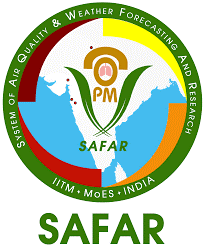SAFAR
- The System of Air Quality and Weather Forecasting And Research (SAFAR) is a national initiative introduced by the Ministry of Earth Sciences (MoES) to measure the air quality of a metropolitan city, by measuring the overall pollution level and the location-specific air quality of the
- The system is indigenously developed by the Indian Institute of Tropical Meteorology (IITM), Pune and is operationalized by the India Meteorological Department (IMD).
- It has a giant true color LED display that gives out real-time air quality index on a 24×7 basis with color-coding (along with 72 hours advance forecast).
- The ultimate objective of the project is to increase awareness among the general public regarding the air quality in their city so that appropriate mitigation measures and systematic action can be taken
- It organizes awareness drive by educating the public (prompting self- mitigation), and
- It also helps the policy-makers to develop mitigation strategies keeping in mind the nation’s economic development.
- SAFAR is an integral part of India’s first Air Quality Early Warning System operational in Delhi.
- It monitors all weather parameters like temperature, rainfall, humidity, wind speed, and wind direction, UV radiation, and solar
- Pollutants monitored: 5, PM10, Ozone, Carbon Monoxide (CO), Nitrogen Oxides (NOx), Sulfur Dioxide (SO2), Benzene, Toluene, Xylene, and Mercury.
- The World Meteorological Organization has recognized SAFAR as a prototype activity on the basis of the high-quality control and standards maintained in its
- SAFAR system would benefit cost savings to several other sectors like agriculture, aviation, infrastructure, disaster management, tourism, which directly or indirectly gets affected by air quality and weather.
Air Quality Index (AQI)
The AQI is an index for reporting daily air quality.
- It focuses on health effects one might experience within a few hours or days after breathing polluted
- AQI is calculated for eight major air pollutants:
- Ground-level ozone,
- PM10,
- PM2.5
- Carbon monoxide,
- Sulfur dioxide,
- Nitrogen dioxide,
- Ammonia,
- Lead,Ground-level ozone and airborne particles are the two pollutants that pose the greatest threat to human health in

